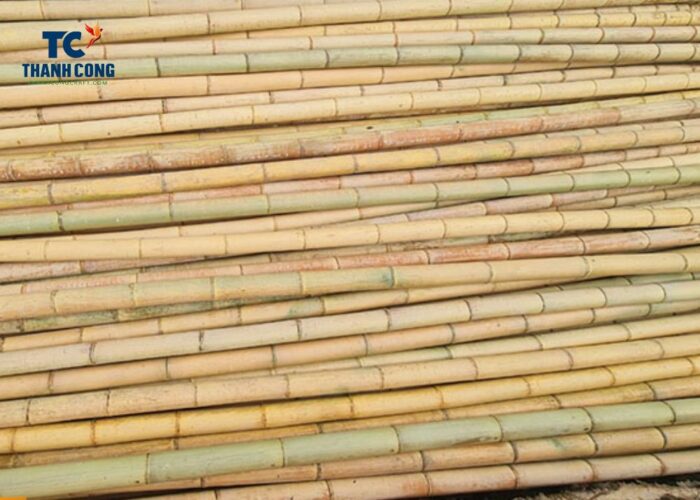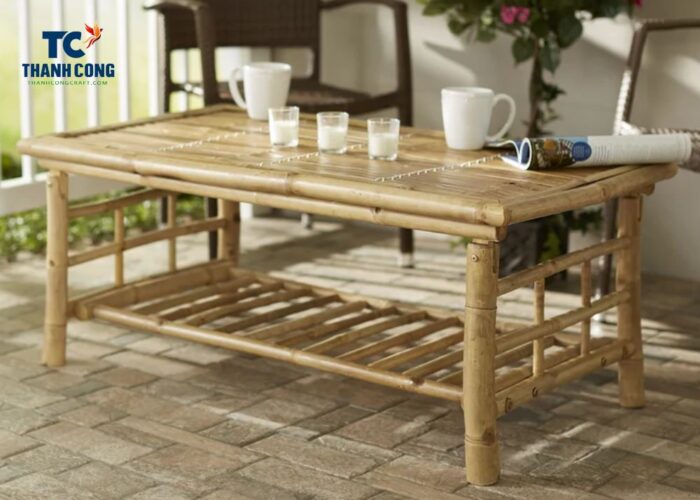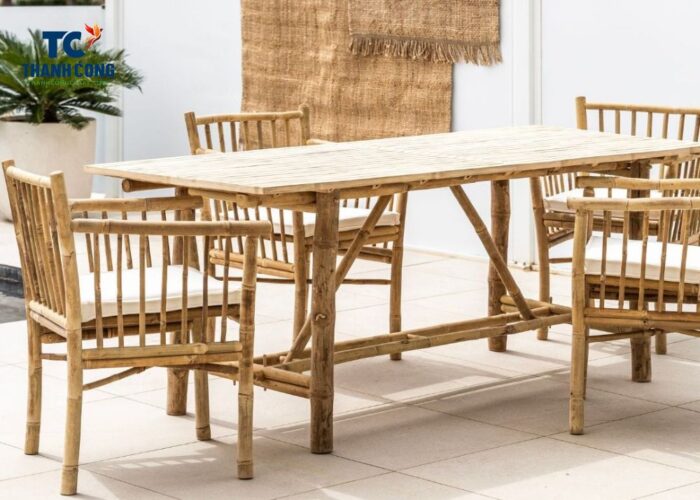DIY a bamboo table can be a rewarding and eco-friendly project that adds a touch of natural elegance to your living space. Making bamboo dining tables, bamboo tea and coffee tables, and other items is an interesting way to decorate your house uniquely.
In this following article, we will walk you through how to make bamboo table step by step. Let’s delve into the fascinating world of bamboo craftsmanship and transform this versatile material into a stylish and functional table for your home.
1. Bamboo Table Making Materials
To make a bamboo table, you’ll need a few essential materials:
- Bamboo Poles: Select sturdy and straight bamboo poles for the table legs and frame. The diameter and length will depend on your design preferences.
- Bamboo Plywood or Board: Use bamboo plywood or boards for the tabletop. It provides a smooth and even surface. Alternatively, you can create a tabletop by securing bamboo slats together.
- Wood Glue: High-quality wood glue will be necessary for bonding bamboo pieces together securely.

- Clamps: Clamps are essential for holding bamboo pieces in place while the glue dries, ensuring a strong bond.
- Saw: A saw will be needed to cut bamboo poles and plywood to the desired lengths and shapes.
- Sandpaper: Sandpaper of varying grits is useful for smoothing the surfaces of bamboo and creating a polished finish.
- Wood Finish or Sealant: Apply a wood finish or sealant to protect the bamboo from moisture and enhance its natural beauty.
- Measuring Tape and Ruler: Accurate measurements are crucial for ensuring that your bamboo table is stable and well-proportioned.
- Pencil or Marker: Use a pencil or marker to mark cutting lines and assembly points on the bamboo.
- Protective Gear: Safety should always be a priority. Wear safety glasses, gloves, and a dust mask when cutting, sanding, and handling bamboo.
Remember to adapt the materials based on your specific design and size requirements. Additionally, consider using sustainably sourced bamboo to align with eco-friendly practices.
2. How to Make Bamboo Table?
Step 1: Constructing the Bamboo Frame
In this initial step, your goal is to build the foundational framework for your bamboo table. Begin by arranging the bamboo pieces parallel to each other, ensuring they are evenly spaced. This arrangement will serve as the basis for the table’s structure.
To secure the bamboo pieces together, utilize a drill to make holes through the bamboo at strategic points along the lengths where they meet. These holes will act as guides for the screws that will join the bamboo pieces.

Proceed to fasten the bamboo together by carefully driving screws through the drilled holes. The result of this process will be a sturdy rectangular frame that forms the skeleton of your table. Ensure that the screws are tightened adequately to guarantee the stability of the frame.
This rectangular frame is a crucial element in providing the necessary support for the tabletop. Its dimensions will largely determine the size of your finished bamboo table, so be meticulous in your measurements and assembly. This step marks a pivotal stage in the construction process, setting the stage for the subsequent detailing and refinement of your bamboo table.
Step 2: Crafting the Tabletop
Moving on to the next crucial step, you will now work on creating the tabletop that will rest upon the bamboo frame. Begin by placing a sheet of plywood on top of the assembled frame, ensuring it aligns with the edges. Take a pencil and carefully trace the outline of the frame onto the plywood. This tracing will serve as a guide for cutting the plywood into the desired shape.
With the outline in place, use a saw to make precise cuts along the penciled lines. Exercise caution and precision during this process to ensure a seamless fit with the bamboo frame. As you complete this step, you’ll end up with a neatly cut rectangular table top that perfectly matches the dimensions of the bamboo frame.
Step 3: Assembling and Refining the Bamboo Table
How to make a table out of bamboo, with the components ready, proceed to affix the tabletop to the bamboo frame. Apply a generous amount of wood glue along the top edges of the frame before carefully placing the plywood tabletop onto it. Ensure that the tabletop is aligned with the frame’s edges for a uniform appearance.

Allow sufficient time for the wood glue to thoroughly dry and create a robust bond between the tabletop and the bamboo frame. Patience during this phase is essential to guarantee the structural integrity of your bamboo table. Once the glue has fully dried, use sandpaper to smooth out any rough edges or corners on the table. This step not only enhances the aesthetics but also ensures a safe and comfortable user experience.
To further protect your bamboo table and enhance its visual appeal, consider applying a coat of paint or a layer of wax. Painting can add a pop of color or match the table to your existing decor, while waxing provides a protective layer that also imparts a glossy finish.
Step 4: Selecting and Attaching Table Legs
In this pivotal step, you’ll personalize your bamboo table by choosing legs that complement its size and style. Opt for either shorter bamboo pieces or explore alternative materials for a unique touch. Once you’ve made your selection, it’s time to attach the legs securely.
Employ a drill to create holes both on the chosen table legs and the corresponding positions on the bamboo frame. These holes will serve as guides for the screws that will fasten the legs to the frame. Be mindful of alignment and stability during this process to ensure the legs are securely and evenly attached.
By completing this step, you not only enhance the functionality of your bamboo table but also contribute to its overall aesthetic appeal.
3. FAQs
3.1 Is Bamboo A Good Material for Table?
Yes, bamboo is generally considered a good material for tables, and it comes with several advantages:
- Sustainability: Bamboo is a highly sustainable material as it grows rapidly, making it an eco-friendly choice compared to traditional hardwoods.
- Strength and Durability: Despite being lightweight, bamboo is incredibly strong and durable. It can withstand heavy loads and is resistant to warping or cracking.
- Aesthetics: Bamboo has a natural and aesthetically pleasing look. Its light color and grain patterns can add a touch of warmth and elegance to any space.
- Versatility: Bamboo is a versatile material that can be crafted into various shapes and sizes. This versatility allows for creative and customized table designs.
- Easy Maintenance: Bamboo tables are relatively easy to maintain. They are resistant to moisture, and regular dusting or wiping with a damp cloth is usually sufficient to keep them clean.
- Environmental Impact: Choosing bamboo over other materials can contribute to reducing deforestation, as bamboo grows much faster than hardwood trees.
3.2 What Do You Seal Bamboo with?
To seal bamboo and protect it from moisture, you can use various sealants or finishes. Here are a few options:
- Polyurethane Sealant: Polyurethane is a commonly used sealant for bamboo. It forms a clear, protective layer on the bamboo surface, providing resistance against water and other environmental factors. Choose a water-based polyurethane for an eco-friendly option.
- Tung Oil: Tung oil is a natural oil that can be used to seal and finish bamboo. It enhances the natural beauty of bamboo and provides a protective layer. Tung oil is preferred by some for its non-toxic nature.
- Linseed Oil: Linseed oil is another natural oil that can be used to seal bamboo. It penetrates the bamboo, enhancing its natural color and providing a protective coating. However, linseed oil tends to darken over time.
- Beeswax: Beeswax can be used as a natural sealant for bamboo. It forms a protective layer on the surface, making the bamboo more resistant to moisture. Beeswax can be applied alone or in combination with other oils.
- Shellac: Shellac is a natural resin that can be used as a sealant for bamboo. It provides a glossy finish and helps protect the bamboo from moisture. Shellac can be applied in various forms, such as liquid or flakes dissolved in alcohol.
3.3 Does Bamboo Furniture Warp?
One of the advantages of bamboo furniture is its good resistance to deformation. Bamboo is a natural material with high durability, which can withstand different temperatures and humidity levels. However, no material is perfect, and bamboo can also deform if not properly cared for. To keep your bamboo furniture beautiful and durable, you should pay attention to the following things:
- Do not expose bamboo furniture to direct sunlight or too high heat sources, as this can cause bamboo to dry out, shrink and crack.
- Do not place bamboo furniture in places that are too wet, as this can cause bamboo to mold, rot and swell.
- Do not expose bamboo furniture to strong detergents, as this can cause bamboo to fade and wear out.
- Regularly wipe bamboo furniture with a soft cloth or small brush, to remove dust and other impurities. You can use a mild soap solution or wood oil to clean and protect bamboo.
- When not using bamboo furniture, you should cover them with cloth or nylon, to avoid the effects of weather and insects.
In conclusion, crafting a bamboo table step by step allows for the creation of a unique and sustainable piece of furniture that seamlessly blends functionality with natural elegance.
By carefully selecting furniture making materials, creating a sturdy frame, customizing the tabletop, and finishing with attention to detail, you can produce a table that not only serves a practical purpose but also enhances the aesthetic appeal of your living space.
The above article is about how to make bamboo table, If you have any further questions, don’t hesitate to send thanhcongcraft an email us at info@thanhcongcraft.com or message us at WhatsApp: +84967485411. Hope to serve you soon! Best regard!












